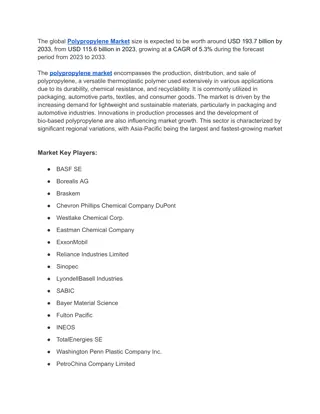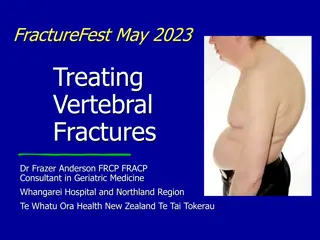Incidence of Mesh Fractures in Open Ventral Hernia Repair with Mediumweight Polypropylene Mesh
This study aims to characterize the occurrence of mesh fractures in open ventral hernia repair using mediumweight polypropylene mesh and identify associated risk factors. The research focuses on patients at Cleveland Clinic from January 2014 to April 2022, emphasizing retromuscular placement and a one-year follow-up. The study excludes minimally invasive approaches, alternative mesh locations, and non-spontaneous mesh fractures.
Download Presentation

Please find below an Image/Link to download the presentation.
The content on the website is provided AS IS for your information and personal use only. It may not be sold, licensed, or shared on other websites without obtaining consent from the author.If you encounter any issues during the download, it is possible that the publisher has removed the file from their server.
You are allowed to download the files provided on this website for personal or commercial use, subject to the condition that they are used lawfully. All files are the property of their respective owners.
The content on the website is provided AS IS for your information and personal use only. It may not be sold, licensed, or shared on other websites without obtaining consent from the author.
E N D
Presentation Transcript
Mediumweight polypropylene mesh fractures after open retromuscular ventral hernia repair: Incidence and associated risk factors Sara Maskal, MD General Surgery Resident Cleveland Clinic Foundation Co-authors: Benjamin Miller, MD Ryan Ellis, MD Sharon Phillips, MS Ajita Prabhu, MD Lucas Beffa, MD David Krpata, MD Steven Rosenblatt, MD Michael Rosen, MD Clayton Petro, MD
Disclosures Study Funding: - none Clayton Petro - BD Consultant - Surgimatix Consultant - Research Grants AHS, CSA, SAGES Ajita Prabhu - Speaking fees and research support paid to institution from Intuitive Surgical - Consulting fees and is on the Advisory Board for CMR Surgical - Consulting fees from Verb Surgical Lucas Beffa - Honoraria from Intuitive Surgical Michael Rosen - Medical director of ACHQC - Stock options with Ariste
Background Warren JA, McGrath SP, Hale AL, Ewing JA, Carbonell AM, Cobb WS. Patterns of Recurrence and Mechanisms of Failure after Open Ventral Hernia Repair with Mesh. Am Surg. 2017;83(11):1275-1282. doi:10.1177/000313481708301131
Background Definitions of weight: - Lightweight (<40 g/m2) - Mediumweight (40-60 g/m2) - Intermediate weight (60- 75 g/m2) - Heavyweight (>75 g/m2) Krpata DM, Petro CC, Prabhu AS, et al. Effect of Hernia Mesh Weights on Postoperative Patient-Related and Clinical Outcomes After Open Ventral Hernia Repair: A Randomized Clinical Trial. JAMA Surg. 2021;156(12):1085 1092. doi:10.1001/jamasurg.2021.4309
Background Are mesh fractures common enough that we should abandon mediumweight mesh?
Specific Aims Characterize the incidence of mesh fractures in OVHR with mediumweight polypropylene (MWPP) Identify associated risk factors
Inclusion/Exclusion Criteria Inclusion - Adult patients - Open ventral hernia repair - Retromuscular placement of MWPP - Cleveland Clinic, January 2014 to April 2022 - At least 1-year follow-up Exclusion - MIS approach - Alternative mesh locations - Non-spontaneous mesh fracture - No imaging or operative reports available
Comparators Patients with a mesh fracture Blinded consensus CT review or operative note Patients without a recurrence Negative HRI, CT, or surgeon entered follow up
Variables Variables Demographics Operative details SSI SSO SSOPI Reoperation
Patient Demographics & Comorbidities No mesh fracture (N=644) Mesh fracture (N=28) Test statistic Sex, % Female (N) Race, % White (N) Age, years (median, IQR) BMI, kg/m2 (median, IQR) Active Smoker, % (N) 55% (352) 43% (12) p=0.22 92.5% (594) 61(52-69) 32 (28-36) 23% (34) 85.7% (24) 58 (47-63) 34 (29-36) 12% (1) p=0.19 p=0.12 p=0.27 p=0.59 Comorbidities Ascites Diabetes Dialysis COPD Anti-platelet use Anticoagulant use Immunosuppression History of AAA Recurrent hernia Current active infection 0.34% (2) 20% (128) 0.93% (6) 11% (69) 10% (67) 7% (45) 8.5% (55) 2.3% (15) 55% (356) 2.8% (18) 0% (0) 25% (7) 3.57% (1) 14% (4) 0% (0) 7.1% (2) 28.6% (8) 0% (0) 61% (17) 0% (0) p=0.76 p=0.51 p=0.18 p=0.55 p=0.072 p=0.98 p<0.001 p=0.61 p=0.57 p=0.37
Operative Details No mesh fracture 99.38% (640) Mesh fracture 96.43% (27) p p=0.08 Elective case, % (N) 15 (12-18) 23 (19-26) 900 (900-1600) 83.7% (539) 23% (147) 5.3% (34) 25 (23-30) 25 (23-30) 900 (900-2500) 92.6% (25) 18% (5) 11% (3) p<0.001 p=0.004 p=0.01 p=0.22 p=0.54 p=0.19 p=0.69 Hernia Width (median [IQR], cm) Hernia Length (median [IQR], cm) Mesh Area (median [IQR], cm2) Mesh Fixation % Concomitant Procedure Intraoperative Complications CDC wound status, % (N) Clean Clean-contaminated Contaminated Dirty/infected Bridged closure, %(N) 69.41% (447) 14.6% (94) 15.9% (101) 0.31% (2) 3.3% (21) 78.6 % (22) 7.1% (2) 14.3% (4) 0% (0) 33.3% (9) p<0.001
Short-Term Clinical Outcomes No mesh fracture 3.1% (20) 37% (238) 8.9% (57) 12.3% (79) 11% (73) Mesh fracture 3.6% ( 1) 54% (15) 17.9% (5) 7.1% (2) 14% (4) Test statistic p=0.89 p=0.08 p=0.11 p=0.41 p=0.50 Reoperation Post-operative complications (any) Surgical site infection (SSI) Surgical site occurrences (SSO) SSI/SSO requiring procedural intervention
Summary Incidence of mesh fractures with MWPP is alarmingly high (4.2%) - At our center: 400 complex reconstructions =12 central mesh failures/year Anterior fascial bridging has a fracture rate of 30%! - 10x higher risk than if fascial closure is obtained
Conclusions Surgeons should be aware of MWPP vulnerability to fracture and weigh risks/benefits Industry should be aware of the blind spot in today s synthetic mesh market - Larger pieces of HW mesh and/or a macroporous HW alternative























